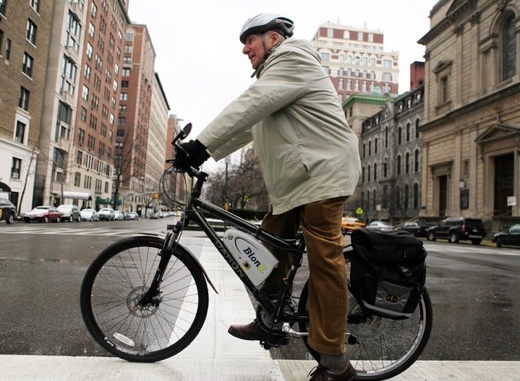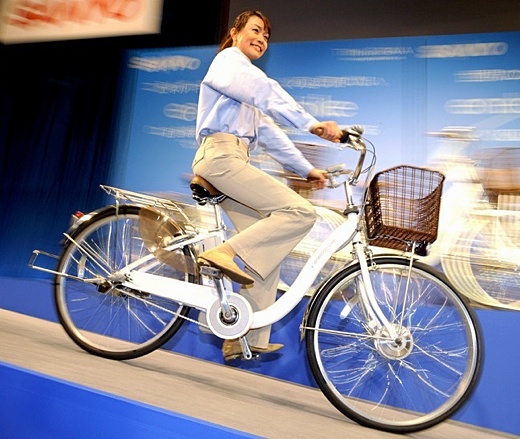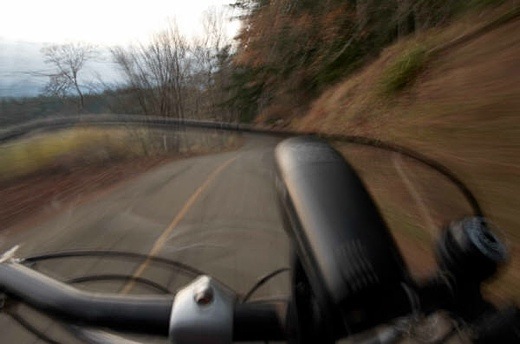 Image above: “It’s miraculous — it takes the hills out of riding,” said Roger Phillips, 78, who rides an electric bike around Manhattan.
By David Goodman on 31 January 2010 in the New York Times -
(http://www.nytimes.com/2010/02/01/business/global/01ebike.html)
Jiang Ruming, a marketing manager, owns a van, but for many errands, he hops on a futuristic-looking contraption that lets him weave rapidly through Shanghai’s messy traffic. He rides an electric bicycle.
Half a world away, in San Francisco, the president of that city’s board of supervisors, David Chiu, uses an electric bike to get to meetings without sweating through his suit.
Image above: “It’s miraculous — it takes the hills out of riding,” said Roger Phillips, 78, who rides an electric bike around Manhattan.
By David Goodman on 31 January 2010 in the New York Times -
(http://www.nytimes.com/2010/02/01/business/global/01ebike.html)
Jiang Ruming, a marketing manager, owns a van, but for many errands, he hops on a futuristic-looking contraption that lets him weave rapidly through Shanghai’s messy traffic. He rides an electric bicycle.
Half a world away, in San Francisco, the president of that city’s board of supervisors, David Chiu, uses an electric bike to get to meetings without sweating through his suit. And in the Netherlands, Jessy Wijzenbeek-Voet recently rode an electric bicycle on a long trip that, at 71, she would not have been able to make on a standard bike.
Detroit may be introducing electric car designs and China may be pushing forward with a big expansion of its highways and trains. But people like Mr. Jiang, Ms. Wijzenbeek-Voet and Mr. Chiu — as well as delivery workers in New York, postal employees in Germany and commuters from Canada to Japan — are among the millions taking part in a more accidental transportation upheaval.
It began in China, where an estimated 120 million electric bicycles now hum along the roads, up from a few thousand in the 1990s. They are replacing traditional bikes and motorcycles at a rapid clip and, in many cases, allowing people to put off the switch to cars.
In turn, the booming Chinese electric-bike industry is spurring worldwide interest and impressive sales in India, Europe and the United States. China is exporting many bikes, and Western manufacturers are also copying the Chinese trend to produce models of their own. From virtually nothing a decade ago, electric bikes have become an $11 billion global industry.
“It’s miraculous — it takes the hills out of riding,” said Roger Phillips, 78, who rides an electric bike around Manhattan. The sensation is akin to a moving walkway at the airport, he said.
Electric bikes have been a “gift from God” for bike makers, said Edward Benjamin, an independent industry consultant, not only because they cost more — typically $1,500 to $3,000 — but also because they include more components like batteries that need regular replacement.
In the Netherlands, a third of the money spent on bicycles last year went to electric-powered models. Industry experts predict similar growth elsewhere in Europe, especially in Germany, France and Italy, as rising interest in cycling coincides with an aging population. India had virtually no sales until two years ago, but its nascent market is fast expanding and could eclipse Europe’s in the next year.
“The growth has been tremendous in the last two years,” said Naveen Munjal, managing director of Hero Electric, a division of India’s largest bicycle and motorcycle maker. He expects sales at Hero to increase to 250,000 electric bikes in 2012, from 100,000 in 2009.
While the American market has been modest — about 200,000 bikes sold last year, by some estimates — interest is rising, said Jay Townley, a bicycle industry consultant. Best Buy began selling electric bicycles in June at 19 stores in San Francisco, Los Angeles and Portland, Ore. Trek, a manufacturer based in Wisconsin, recently began selling a bike created by Gary Fisher, a prominent bicycle designer.
“Electric-assisted bicycles will change how people think about bikes in urban areas,” predicted Mr. Chiu of San Francisco, who has been riding a prototype of the Trek bike since the summer.
Improvements in technology are resulting in lighter designs that appeal to older cyclists. “Now you’ve got a product you can present to a baby boomer,” Mr. Townley said.
New York City’s largest electric bike store, NYCeWheels, opened in 2001, and in the last few years, business has been growing, said Bert Cebular, the owner. In Chinatown, electric bikes are showing up on nearly every corner and several shops have recently appeared, selling bikes imported from Chinese factories.
As the global market develops, two types of electric bikes are emerging. One is similar to a standard bicycle with pedals, but it has an electric motor that engages on command or when the cyclist pedals. These are the most popular type in the United States and Europe, with many people using the electric motor mainly for help in wind or on steep hills.
By contrast, in China, electric bicycles have evolved into bigger machines that resemble Vespa scooters. They have small, wide-set pedals that most cyclists do not use as they travel entirely on battery power. The bikes move at up to 30 miles an hour, with a range of 50 miles on a fully charged battery.
Gaining a Toehold for the E-Bike
 Image above: Sanyo has introduced its Eneloop Hybrid bike, priced at $2,300, in the United States.
Image above: Sanyo has introduced its Eneloop Hybrid bike, priced at $2,300, in the United States.
By Brad Stone on 16 January 2010 in the New York Times - (http://www.nytimes.com/2010/01/17/business/17ping.html)
Technology has eliminated many of life’s milder physical demands, like getting off the couch to change the channel, or going to the store to buy a book.
The latest exertion to be conquered: biking uphill.
Electric bicycles — a regular pedal-driven bike with a motor for steeper slopes and an optional extra boost — is an idea that has been around for more than a century. But while e-bikes have caught on in certain parts of the world, particularly China, where tens of millions are sold each year, they have never quite captured the imagination of auto-obsessed Americans.
That may be about to change. At the Consumer Electronics Show in Las Vegas this month, Sanyo, the Japanese electronics maker and a major producer of car batteries, showed off a sleek, lightweight e-bike called the Eneloop Hybrid Bicycle.
The Eneloop, priced at $2,300, came to stores in the United States late last year. It operates like any normal bike and, save for the black lithium-ion battery strapped to the frame beneath the seat, looks exactly like one as well. But when you press a button on the left handlebar, a 250-watt motor gently kicks in, providing about twice the power as your own pedaling — and making you feel like Lance Armstrong on even the steepest slopes.
“The average auto trip in the U.S. is five miles or less,” said David Cabanban, bicycle business manager at Sanyo North America. “At the end of the day, how do you lower pollution and get people healthy? We’ve got to get people back to riding bikes.”
For years, e-bike proponents have argued that these machines can get people to abandon their cars and cut down on pollution, all without working up the unsightly sweat acquired when biking to work. But early e-bikes were never very good.
In the 1990s, people like Lee Iacocca and Malcolm Currie, the former chief executive of Hughes Aircraft, got into the e-bike business. Their bikes had heavy steel frames and the same lead acid batteries used in automobiles, which themselves could weigh 80 pounds. The entire Eneloop weights about 50 pounds.
Those older e-bikes (many were more like electric mopeds) often needed repairs and service. And their regulatory status was ambiguous — were they motorcycles? bikes? — so many retailers were afraid to sell them. The federal government resolved the legal obstacle with legislation in 2002, classifying any two-wheel, pedal-driven bike with a maximum speed of 20 miles an hour as a bike, which does not need turn signals or licensed riders.
New technology has addressed the other obstacles. Lead acid batteries have given way to efficient and lighter lithium-ion batteries.
The earliest e-bikes of the 1990s got about 15 miles on a single charge. The Eneloop’s battery can power the bike about 46 miles before it needs to be plugged into an outlet and recharged for around three hours; it also partially recharges when the rider brakes or coasts downhill.
Other e-bike makers brag about similar performance.
“If it wasn’t for the lithium battery I wouldn’t be in this business. It’s made this category possible,” said Marcus Hays, founder of Pi Mobility, a company in Sausalito, Calif., whose red, angular bikes cost $2,500 and can operate as a bike, a moped or both at the same time.
E-bike makers in the United States saw something of a mini-boom in 2008, when gasoline prices spiked and people started looking for eco-friendly alternatives to the automobile.
Some basic e-bike models, like the Ezip Trailz by Currie Technologies, now sell for as low as $500. Trek and Schwinn, traditional bike makers, both began selling e-bikes last year, the latter in conjunction with Toshiba.
E-bike makers say that some of the stigma surrounding the bikes — critics see them as a tool to avoid actual exercise — has faded.
“Four years ago, we encountered many people saying, ‘Oh wow, we are so lazy, we need motors on our bikes’ ” said Scott Shaw, president of EcoBike USA, an e-bike maker in Southern California. “Now people are understanding and saying, this is more a utilitarian vehicle for commuting and getting outside on two wheels rather than four.”
RETAILERS have also sensed the growing opportunity. Big-box stores like Wal-Mart, Sears and Costco have dabbled in the category for about a decade. Last year, Best Buy started selling e-bikes experimentally in three test markets: Los Angeles, San Francisco and Portland, Ore.
E-bikes, like regular bikes, still face plenty of challenges. In many parts of the world, biking is an important form of transportation; in the United States it is seen primarily as recreation. Many major cities still do not have bike lanes, and the most important sales channel in the industry — independent bike shops — has been shrinking for more than a decade.
But there may be a greater challenge for companies like Sanyo and other e-bike makers. People tend to think of their transportation, like their clothes or cellphones, as an expression of their identity.
In China, riding an electric bike conveys professional achievement, even a certain degree of wealth. People in the United States, said Ed Benjamin, an independent consultant in the bike business, don’t quite know whether these bikes are fashionable. The e-bike is “an ambiguous statement,” Mr. Benjamin said.
The next few years, he said, could bring higher prices for gasoline and airline tickets. “We have to make some fundamental changes, and e-bikes can be a part of that,” he said.
Electric Biker
 The machine waits, eager and enticing, as I pull on helmet, goggles and gloves and zip my armored jacket to the chin. The charger's pulsing green light says, “Go!”
The machine waits, eager and enticing, as I pull on helmet, goggles and gloves and zip my armored jacket to the chin. The charger's pulsing green light says, “Go!”
No comments :
Post a Comment